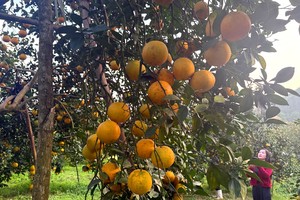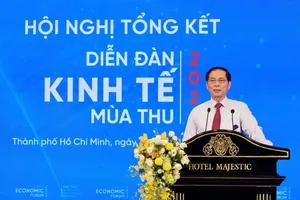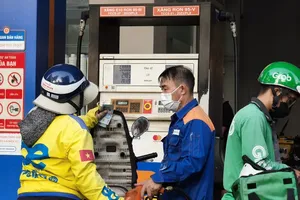
Smooth ride, with no emissions
At the beginning of August, Nguyen Van Thong and his family from Binh Duong enjoyed the green space at Dam Sen Cultural Park in District 11, Ho Chi Minh City, using electric vehicles. "The ride is so smooth, with no emissions. My kids love it," Thong said.
According to estimates from the amusement park, there are about 4,000 visitors daily, with peak times reaching over 10,000 visitors. The park has around five small cars and two fairy tale trains (three cars per train) dedicated to transporting visitors within the park. Each vehicle can accommodate 8-10 people. Passengers who wish to use electric vehicles can choose from various ticket options, ranging from VND50,000 to VND300,000, depending on the route and the number of passengers per trip.
Similar to Dam Sen, many other amusement parks, such as Suoi Tien Cultural Park (Thu Duc City, Ho Chi Minh City) and Son Tien Tourist City (Dong Nai), have also equipped themselves with dozens of new electric vehicles to serve visitors better. Representatives from these parks highlight that their expansive recreational areas offer a variety of activities, including zoo visits and thrill rides. With millions of visitors each year, investing in modern, eco-friendly transportation is a key focus for Suoi Tien and Son Tien.
However, not all places have managed to invest in electric vehicles in time to handle the increasing number of tourists in Ho Chi Minh City. For example, Saigon Zoo and Botanical Garden in District 1 still uses old gasoline-powered vehicles that emit black smoke, which can deter visitors. Before the Covid-19 pandemic, Saigon Zoo had two small electric vehicles with a capacity of about eight passengers each, but these are now out of use, leaving only the outdated gasoline-powered vehicles.
"Two days ago, my wife and I took our child out. While walking, black smoke from a passenger vehicle blew directly into our faces, causing us to sneeze continuously. It’s not a big issue for adults, but it’s quite concerning for children," said Nguyen Quang Toan from Binh Chanh District (Ho Chi Minh City).
Further afield, in destinations like Phu Quoc, Tay Ninh, and Ninh Binh, tourist sites operated by Vingroup, Sungroup, and Trang An Golf Club have invested in electric vehicles for transporting visitors. The number of these vehicles ranges from a few dozen to several hundred. They provide a smooth ride without the smell of gasoline or oil and without emitting smoke and dust, allowing visitors to fully enjoy their time with family and friends. Even remote areas like U Minh Ha National Park (Ca Mau) have equipped their boats with electric engines instead of gasoline-powered ones to protect the environment and ensure visitor safety and health.
New investments, developing "green" vehicles
A few months ago, Saigon Zoo and Botanical Garden approved a plan to select a contractor for new vehicle procurement for its operations, with a budget of over VND1 billion. Among the new vehicles will be electric cars to serve visitors. According to Ms. Huynh Thu Thao, Chairwoman of the Management Board of Saigon Zoo and Botanical Garden Company, this investment in new vehicles aims to green the transportation options for visitors, enhance their experience, and attract both domestic and international tourists.
From the perspective of a specialized agency, Mr. Tran Ngoc Dong Quan, Head of the Travel Management Department at the Ho Chi Minh City Department of Tourism, notes that environmental protection and sustainable development have become top priorities for society, and the tourism industry is no exception. Currently, electric and green energy public transportation options are emerging trends that enhance attractiveness, diversify services, and better meet the needs of tourists. Accordingly, the Department of Tourism supports and encourages the development of transportation services using electric and green energy, which are environmentally friendly.
In the short term, the Ho Chi Minh City Department of Tourism is facilitating the development and integration of electric and clean fuel transportation options with various travel agencies to create tours and routes and connect attractions in pilot transportation projects. Additionally, the Department encourages including these transportation options in tourism events such as Tourism Week, the River Festival, and the International Tourism Fair ITE 2024.
"Moving forward, the Department of Tourism will continue to collaborate with organizations that prioritize electric and clean energy vehicles to enhance tourist experiences and contribute to reducing environmental impacts," said Tran Ngoc Dong Quan.
Ms. Nguyen Thi Khanh, Vice Chairwoman of the Vietnam Tourism Association and Chairwoman of the Ho Chi Minh City Tourism Association:
Support for policies and funding
Countries like Singapore, the Netherlands, and Sweden offer substantial government support for developing electric public transportation, including infrastructure, landscaping, environmental measures, and policies. In Vietnam, many tourist areas in various provinces and cities are gradually investing more in electric vehicles to serve visitors. This approach is clearly positive and aligns with global trends. However, the transition requires government support in terms of policy mechanisms and funding.
























